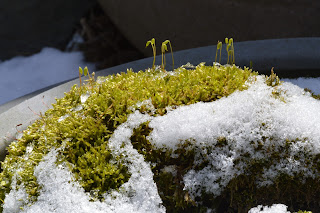Garden construction--2010-2015
Finally, the history of my garden's construction comes to the end of last year. Whew! I get tired just looking at all the work (a.k.a. play) I did since 1970. It was a journey filled with joy and learning. But I also endured no small amount of frustration, finding out that in my next life I will
not be a carpenter, stone mason, or plumber, as I had to be all those to get the gardens to this point.
The first photo shows a planter built of antique bricks alongside the steps off the back lawn to the Terrace Garden in 2010. Also in 2010, Photo 2 shows the laying of the sandstone cobblestone path leading to the underground shed.
Photos 3 & 4 shows the construction of a stone terrace in the Terrace Garden.
Photo 5 shows the construction of the sandstone cobblestone path leading to the southwest corner of the property in 2011. Photo 6 shows me trying to get a hernia or a pulled back setting some large boulders near that path.
I built a planter near the back of the lot out of smaller grey cobblestones I collected in Buffalo Street in Milwaukee in 2011, shown in Photos 7 & 8.
Photos 9-11 show the construction from October to December of 2011 of the pergola on the hill in the northwest part of the property. At the same time, I built a planter/bench out of granite cobblestones just to the south of the pergola, shown in Photos 12-14. I probably had the most frustration in any project here in 46 years--but the view overlooking the back yard is my favorite in the entire garden, so I guess it was worth it.
I finally finished the Williamsburg Garden after 35 years in 2012 when I built a brick wall on the west boundary of the garden. This is shown in Photos 15-17.
The raised bur oak seating area in the southwest corner was rotting, so it needed replacement. I decided to not replace it, so I dug down four feet to make a sunken garden instead, constructing it out of big stones. This project, done in 2012, is shown in Photos 18-20. After finishing that, I added a new walkway behind it just to the south, shown in Photo 21. Actually, it is mainly on my neighbor's property. (Not surprising, I encroach on four of my neighbors' properties.)
I built a container garden with moss amongst a Japanese maple for a TV show,
The Wisconsin Gardener, in 2012. It is shown in Photo 22.
In 2013 I doubled the size of my Japanese garden and built a fence around it out of i
pe, a Brazilian wood. Photo 23 shows part of that fence. Photo 24 shows me adding a bamboo pipe in 2013 for a water system in the enlarged Japanese garden. I started building an
azumaya (viewing house) in that enlarged garden in Fall 2013. Photo 25 shows me peeling the poles that appear set in place in Photo 26. I finished the building in early 2014, shown in Photos 27-30. I used a tool to split the bamboo that is used on the ceiling. The hanging light fixture I designed in 1980, when I built several prototypes. This light was built by a cabinet maker in 2014.
Photos 31 & 32 shows the planter of granite cobblestones I built under the pergola in 2015.
Also in 2015 I installed two handrails, which is shown in Photo 33.
Well, that is the past. The future promises several major and minor projects, thankfully, as I get almost as much enjoyment from anticipating these projects as I do viewing them.



















































